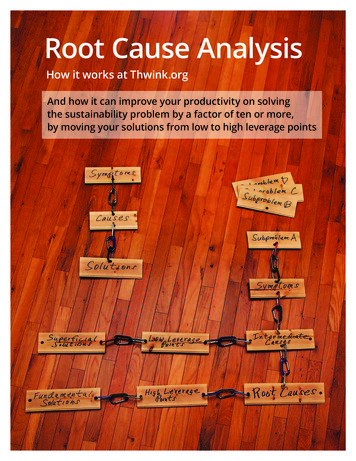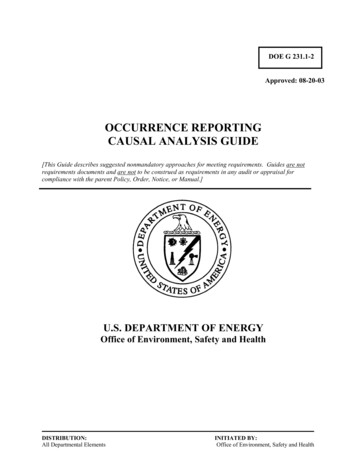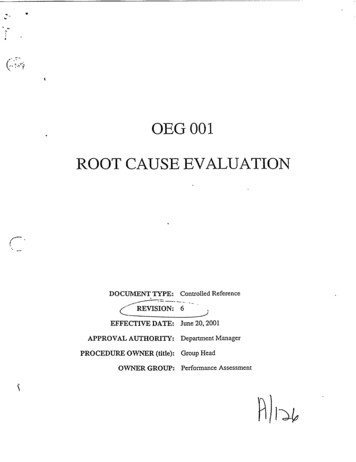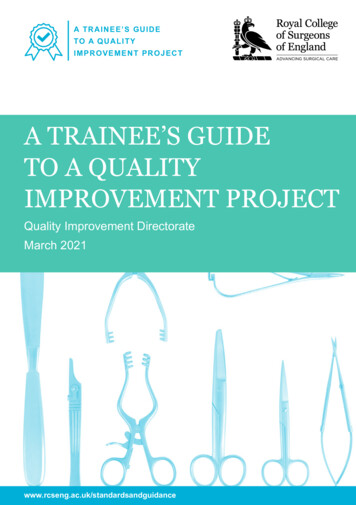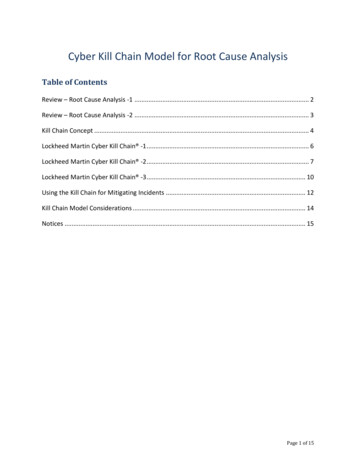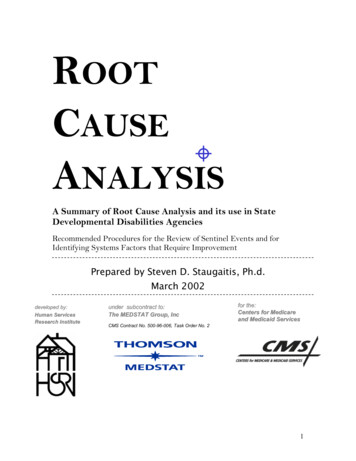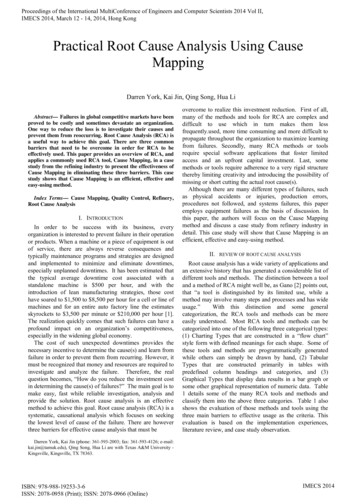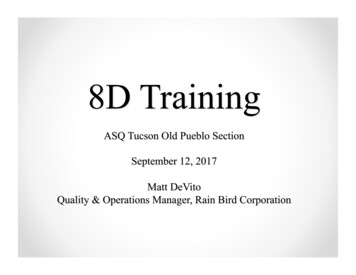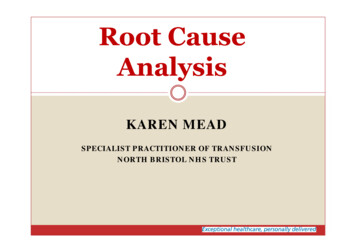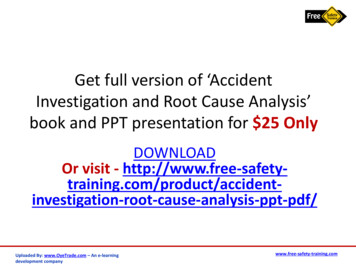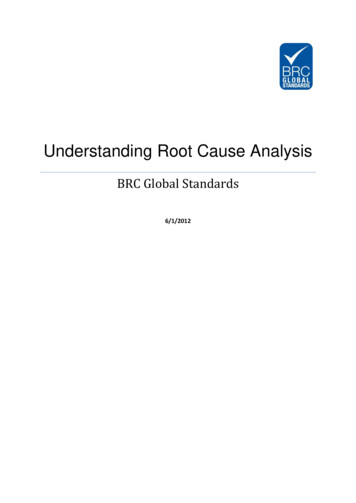
Transcription
Understanding Root Cause AnalysisBRC Global Standards6/1/2012
Contents1.What is Root Cause Analysis? . 12.Where in the Standard is RCA Required?. 33.How to Complete Root Cause Analysis?. 34.Methods of Root Cause Analysis . 54.1 The ‘5 Whys’:. 54.2 Fishbone Diagrams: . 75.Common Mistakes . 95.1 Unmanageable Conclusions . 95.2 Duplication of the Immediate Corrective Action . 105.3 People . 115.4 Proposed Action Plan Doesn’t Prevent Re-occurrence . 125.5 Extra Checks . 146.Preventative Action . 147.Additional Documentation . 158.Glossary of Terms . 159.Appendices . 169.1 Inclusion of Root Cause Analysis in the Audit Report . 169.2 ‘5 Whys’ Route Cause Analysis Template . 189.3 Fishbone Diagram Template. 191. What is Root Cause Analysis?Root cause analysis is a problem solving process for conducting an investigation into anidentified incident, problem, concern or non-conformity. Root cause analysis is a completelyseparate process to incident management and immediate corrective action, although they areoften completed in close proximity.Root cause analysis (RCA) requires the investigator(s) to look beyond the solution to theimmediate problem and understand the fundamental or underlying cause(s) of the situationand put them right, thereby preventing re-occurrence of the same issue. This may involve theidentification and management of processes, procedures, activities, inactivity, behaviours orconditions.The benefits of comprehensive root cause analysis include:BRC026 Issue 1Released 13/6/2012Understanding Root Cause AnalysisPage 1 of 20
Identification of permanent solutionsPrevention of recurring failuresIntroduction of a logical problem solving process applicable to issues and nonconformities of all sizesSteps to Root Cause AnalysisStep 1Define the Non-ConformityStep 2Investigate the Root CauseStep 3Create Proposed Action Plan & Define TimescalesStep 4Implement Proposed ActionStep 5Verification & Monitoring of EffectivenessIt should be noted that this is a simplified process flow, which is typical of the majority ofsituations required by the BRC Standards. However, for a complex non-conformity, such as aserious incident involving a microbiological outbreak, root cause analysis will becomeproportionally more detailed, require extra activities and can require considerable time. Forexample, some or all of the following steps may be required: Establish a root cause team to investigate the issueCompilation of a summary of the event or non-conformity (ie a summary of what waswrong)Confirmation of the sequence of events (for example if a customer illness, led toproduct analysis, which subsequently led to a raw material investigation then thedates and results of each step may provide useful information)List of dates/times (for example when the non-conformity was discovered and whenthe last acceptable monitoring result of the implicated process was obtained)A list of implicated products/ingredients (raw materials) or processesA summary of any incident management or immediate corrective action that hasbeen completedAny other relevant data or information (for example records, test results, informationfrom staff in the relevant area or complaints)BRC026 Issue 1Released 13/6/2012Understanding Root Cause AnalysisPage 2 of 20
Collation of all available informationInvestigation of possible scenarios & collation of information (for example this mayinclude product or environmental testing or liaison with technical experts andregulatory authorities).2. Where in the Standard is RCA Required?An important part of any non-conformity management is the identification of the root causeand the implementation of suitable action. There are a number of requirements in the BRCStandards for root cause analysis:Food Standard Issue 6:ClauseRequirementSenior management to ensure the root cause of audit non1.1.10 conformities have been effectively addressed to preventrecurrence.Identification of the root cause of non-conforming products and3.7.1implementation of any necessary corrective action.Root cause analysis and associated actions relating to customer3.10.1complaints.AuditFollowing an audit, the root cause of non-conformities shall beProtocolidentified and an action plan to correct this, including timescales,9.2 &must be provided to the Certification Body.9.2.2Consumer Products Standard Issue 3Review of risk assessment and evaluation of complaints /2.4.2incidents3.7.4Corrective actions and prevention of re-occurrence3.12.4 Analysis of complaint dataPackaging Standard (Issue 4)There are no requirements for root cause analysis in thePackaging Standard, but sites are required to state “correctiveaction taken (with consideration of root cause)” in the auditreport.3. How to Complete Root Cause Analysis?There is no single prescribed method of conducting root cause analysis and any structuredapproach to identifying the factors that resulted in the non-conformity could be used, manytools and methods have therefore been published (two popular methods are highlightedbelow). The choice of root cause methodology may be a matter of personal choice, companypolicy or dependent on the type of issue/non-conformity being investigated. Some companiesBRC026 Issue 1Released 13/6/2012Understanding Root Cause AnalysisPage 3 of 20
find different tools work better for different types situations, for example based on the size orcomplexity of the incident or the type/source of data.Whichever method of root cause analysis is used it is usually necessary to commence with,and record the known facts. Depending on the situation these may include: What the non-conformity isWhen it occurred and when it was discoveredImplicated products/processesAny immediate corrective action completedThroughout the process it should be remembered that the key question that root causeanalysis is seeking to answer is: What system or process failed so that this problem couldoccur?On some occasions the reason is straightforward – ’Why did this occur?’ ‘The documented policy didn’t include the requirement’ or‘The procedure wasn’t trained to staff’In these situations the subsequent steps of the investigation and action can be plannedimmediately.On other occasions the cause is not immediately clear and investigative steps will berequired, for example: Does the operator understand the procedure?Does the method laid out in the policy work if followed precisely?Does the specified time/temperature achieve the expected outcome?In these situations it is necessary to gather and collate evidence, for example: Talk to the operator to establish the level of understandingTake the method into the appropriate factory area and follow it through precisely aswrittenReview the original shelf life or processing dataWhere appropriate complete new or additional tests (for example on raw materials,final product, factory environment or the process)Once this information is collated, it should be possible to draw conclusions or to establish theareas where further focus/questions are required.Once the underlying cause has been established, the next stage of the process is toestablish a proposed action plan, indicating the action that will be taken to prevent the nonconformity recurring. The action plan should include a defined timescale in which the actionwill be completed and define who is responsible for completion.An important final step of an effective root cause analysis is to consider monitoring orverification activity. This is necessary to ensure that the changes to (or new) activity orBRC026 Issue 1Released 13/6/2012Understanding Root Cause AnalysisPage 4 of 20
procedures is fully operational, that it is effective in managing the root cause and that it doesnot inadvertently introduce any additional problems. Example activities could include: Internal audits covering the new processCheck sheets to be completed at the time of the changed processLine start up checksInvestment in new technologyEnd of production/shift countersigning by production or line managerOnce it is demonstrated that an action is fully embedded and effective, a review canconsider whether the additional monitoring is still required or can be reduced to a lowerfrequency.4. Methods of Root Cause Analysis4.1 The ‘5 Whys’:The ‘5 Whys’ is the simplest method for structured root cause analysis.It is a question asking method used to explore the cause/effect relationships underlying theproblem. The investigator keeps asking the question ‘Why?’ until meaningful conclusions arereached.Why?Why?Why?Why?Why?RootCauseIt is generally suggested that a minimum of five questions need to be asked, althoughsometimes additional questions are required or useful, as it is important to ensure that thequestions continue to be asked until the real cause is identified rather than a partialconclusion.As previously mentioned it is usually necessary to obtain information or objective evidence ateach stage of the process, it is also sometimes necessary to re-phrase a question or make itmore specific to obtain meaningful data, for example, instead of simply asking ‘why?’, ask‘why was the operator not trained?’ or ‘why did the training process fail?’ or ‘why was thetraining process not effective on this occasion?’An example of root cause analysis using the ‘5 Whys’:An operator is instructed to perform a simple action ‘weigh out ingredient A’, however theoperator inadvertently used ingredient B instead.BRC026 Issue 1Released 13/6/2012Understanding Root Cause AnalysisPage 5 of 20
An immediate reaction will probably suggest this was caused by an operator error. Whilst thismay be accurate, it does not establish the reason why the error occurred or prevent ithappening in future. The root cause analysis must ask a series of ‘Why?’ questions (andobtain answers), for example:In this example it would be easy for the investigator to stop the analysis part way throughthinking that all the conclusions had been reached (ie that this was purely a training issue),however, the further questions reveal useful information about the nature of the cause andtherefore the appropriate action.The issue actually had a number of causes that contributed to the incident: Incomplete training procedure A faulty cleaning process Lack of post-cleaning check proceduresProposed action can now be planned, for example: Update training procedure to ensure sign off (& possibly a supervision step)Replace ingredient labels – if practical with ones that cannot be removed.If labels must occasionally be removed, ensure that post cleaning line checks includeBRC026 Issue 1Released 13/6/2012Understanding Root Cause AnalysisPage 6 of 20
a check of labels.Ensure an individual (eg the production manager) is authorised and responsible forpost-cleaning line sign off.Ensure cleaning staff fully understand and are trained in the need to return labelling(and all equipment) in a fully operational state.4.2 Fishbone Diagrams:A second commonly used method of root cause analysis, is the use of fishbone diagrams(sometimes referred to a Ishikawa models or Herringbone diagrams). They are most usefulwhen the ‘5 whys’ is too basic, for example, where a complex issue needs to be consideredin bite size pieces or where there is a lot of data that needs to be trended.In the diagram, the various causes are grouped into categories (such as equipment,materials or processes) and the arrows in the image indicate how the causes cascade or flowtoward the non-conformity.The categories are not pre-defined but common ones include: Equipment – this should include consideration of all equipment that could have a rolein the non-conformity, for example, production line, facilities, computers or toolsProcesses or Methods – how work is performed, policies, procedures, rules or workinstructionsMeasurements – any data collection or measurement, either from a process orsubsequent to the non-conformity, for example metal detection records, checkweights or final product analysisMaterials – any information relating to raw materials or final products, for example rawmaterial specification or goods receipt checks for a specific batch of ingredient.Environment – The location, time, temperature, culture, standards of cleanliness oravailable time, for an activity.People – Any role involved in the implicated process.BRC026 Issue 1Released 13/6/2012Understanding Root Cause AnalysisPage 7 of 20
This type of root cause analysis is a causal process, it seeks to understand the possiblecauses by asking ‘what actually happened?’, ‘When?’, ‘Where?’ ‘Why?’, ‘How?’ and ‘Sowhat?’ in other words a possible cause is identified and the consequences and significance isinvestigated for each of the group categories.For example: What happened? - Procedure was not followed correctlyWhy? - Staff member was untrained in the procedureWhen? - Monday morningWhere? - Line 2How? - Staff shortagesSo what? (ie is this important) - The safety of the product could be implicated if theprocedure is not followed correctly. Training processes have not been followedcorrectly.As with the ‘5 Whys’ it is important to initially investigate the cause and then examine thecause of the cause to ensure the root cause has been correctly identified (fishbone diagramssometimes refer to this as examining primary and secondary causes).Example of root cause analysis using the Fishbone Diagram:Using the same scenario as for the ‘5 Whys?’ in which an operator is instructed to perform asimple action ‘weigh out ingredient A’, however inadvertently uses ingredient B. The causeswould be tabulated as discovered and proposed action developed:BRC026 Issue 1Released 13/6/2012Understanding Root Cause AnalysisPage 8 of 20
5. Common MistakesTo help users avoid a number of common mistakes, which are known to hinder the formationof quality proposed action plans, an explanation of each mistake given below. Thisexplanation includes an example of the incorrect approach (indicated by an ‘X’), which isimmediately followed by the same non-conformity being accurately investigated, leading to abetter proposed action plan (indicated by a ‘ ’).5.1 Unmanageable ConclusionsThe root cause should be something that can be managed or changed, which means that itnormally relates to a system or process and occasionally an alterable behaviour. Forexample, it is often tempting to reach a conclusion such as ‘they forgot’, ‘not enough time’,‘not enough money’, ‘not enough staff’, ‘staff sickness’ or ‘made a mistake’, these answersmay be true, but in most cases they are out of our control, whereas root cause analysisshould lead to controllable, manageable or adjustable processes. If these answers areevident it is worth going back into the process to establish whether there is any other cause,for example by asking specific questions such as, ‘Why did the process fail?’ or ‘What systemallowed the mistake to be made?’For example:Corrective actiontakenDetails of Non-conformity Internal audit of suppliermanagement systems scheduledfor January had not been carriedout.BRC026 Issue 1Released 13/6/2012Audit completed.All scheduled auditscompleted and up todate.Understanding Root Cause AnalysisPage 9 of 20Root cause analysis andproposed action plan (PAP)Root Cause: Lack of resource intechnical department due to longterm sickness.PAP: Resource issues to be
Internal audit of suppliermanagement systems scheduledfor January had not been carriedout.Audit completed.All scheduled auditscompleted and up todate.discussed in monthly managementreview.Root Cause: Procedures didn’trecognise the need for deputiesand therefore no alternative staffhad the appropriatequalifications/training when keystaff were on long term sickness.PAP: Internal audit process/policyupdated to incorporate deputies.The size of the internal audit teamwill be increased to includesufficient deputies. These staff willbe trained, as appropriate, for thesystems to be audited.This example again highlights that in practice there may be more than one cause (nodeputies, out of date policy and a lack of training) and therefore the proposed correctiveaction plan may require multiple actions.5.2 Duplication of the Immediate Corrective ActionIt is important that immediate action is taken to correct a non-conformity. However, this isseparate from the root cause analysis and proposed action plan. The purpose of root causeanalysis is to look beyond the immediate non-conformity, to investigate what system orprocess allowed the non-conformity to occur. Once this is established, the proposed actionplan can focus on ensuring that the system or process is amended such that the fault cannotoccur in future. Therefore the proposed action plan should not be a repeat of the immediatecorrective action.For example:Corrective actiontakenDetails of Non-conformity Acceptance and rejection criteriahave not been defined forcalibrated devices.Therefore the actions to take, ifthe device is incorrect or out ofcalibration range were notdefined.Acceptance and rejection criteriahave not been defined forcalibrated devices.Therefore the actions to take, ifthe device is incorrect or out ofBRC026 Issue 1Released 13/6/2012Root cause analysis andproposed action plan (PAP)Acceptance andRoot Cause: Requirement notrejection criteria defineddocumented.and documented.Actions in case of anout of calibration devicedocumented.Action Plan: Calibration procedurehas been updated and informationadded.Root Cause: Neither HACCPAcceptance andrejection criteria defined procedures, calibration procedureand documented.nor installation policiesdocumented the need to defineActions in case of anthese criteria before use of newout of calibration device equipment.Understanding Root Cause AnalysisPage 10 of 20
calibration range were notdefined.documented.PAP: HACCP procedures reviewedand updated to ensure that allsteps are documented and therequirement to validate anychanges to CCPs is documented inthe policy.Policies regarding the purchaseand installation of new equipmentalso updated to reflect requirement.All relevant staff (HACCP team andproduction managers) trained innew requirements5.3 PeopleIt is sometimes tempting to reach a conclusion such as; ‘oversight’, ‘mis-understood’, or‘forgot’, however people are rarely the true root cause and the investigator will need toestablish what system, policy or process allowed the human error to occur.For example:Details of Non-conformity CCP control records were notsigned by the person completingthe monitoring.CCP control records were notsigned by the person completingthe monitoring.Corrective actiontakenTraining completed onthe correct completionof monitoring sheetsand their importance.Re-training designedusing a number ofworksheets where staffwere asked to identify‘good and bad’ records(ie those that werecompleted correctly andthose that had missinginformation)Root cause analysis andproposed action plan (PAP)Root Cause: InexperiencePAP: Raise staff awareness.Root Cause: Effectiveness oftraining for newest members ofstaff was not assessed. CCPworksheets were not checked byeither technical team or internalaudits. (The reason for this shouldalso be subject to root causeanalysis)PAP: Examples of correctlycompleted, annotated CCPworksheet included in workinstructions (copies of which areavailable in production areas).Specific checks on CCP monitoringadded to the internal auditschedule.Verification: Line or productionmanager to countersign CCPrecord sheets at end ofshift/production.BRC026 Issue 1Released 13/6/2012Understanding Root Cause AnalysisPage 11 of 20
In a few situations where individuals are the root cause, for example, a site new tocertification could, during its first audit, discover it has mis-understood a clause of theStandard, there will often be a need for additional training or methods to gain experience orcompetence (for example attending additional training, using an experienced consultant, etc)Where re-training is considered to be a necessary part of the proposed action plan,consideration should be given to the format of the training. If the initial training was noteffective then just repeating the same ineffective training, is unlikely to achieve the desiredeffects. Consider for example; the use of workshop or example based activity, use of pilotplant (where available), work-based training such as observing an experienced colleague,use of external training providers, language in which the training is provided, etc.Throughout the process it must be noted that root cause analysis is not designed toestablish who is to blame for a non-conformity, but to correct the underlying cause andprevent re-occurrence.5.4 Proposed Action Plan Doesn’t Prevent Re-occurrenceOccasionally, despite root cause analysis and the implementation of a proposed action planthe non-conformity re-occurs. There are a number of potential reasons why this mighthappen, including: Incomplete initial root cause analysisIncorrect root cause conclusions (ie the true root cause was not established)Multiple root causes (the proposed action plan needs to manage every root cause)Proposed action plan not fully implemented or trained to staffIn these situations it may be necessary to re-visit the root cause analysis and identifyadditional causes and appropriate controls.Example 1:Corrective actiontakenDetails of Non-conformity The company procedure statesthat weekly production meetingsare held to verify theeffectiveness of the HACCP plan.However, there is no evidenceavailable to demonstrate thatthese meetings are being held.There is no evidence available todemonstrate that these meetingsare being held on a weekly ormonthly basis.BRC026 Issue 1Released 13/6/2012Procedure changed tomonthly meetings.Root cause analysis andproposed action plan (PAP)Root Cause: Weekly meeting notsustainablePAP: Change to monthly meetingsRoot Cause: Meetings occurred onan ad hoc basis but didn’t haveagenda or minutes.A meeting was carriedout.Understanding Root Cause AnalysisPage 12 of 20PAP: Formalise meetings withagenda and minutes. Identify teammember responsible for agendaand minutes. Schedule meetings for
the year ahead and put thedates/times and locations into theteam members diaries.Example 2: IncidentDetails of nformationDairy dessert waspacked into non-dairypackaging andreleased to customers(Non-dairy dessertdoes not contain milkwhich could cause areaction in an allergicindividual)Manualchecks onpackedproductsindicatethat mispacks stilloccur.Product mis-packed.The previous rootcause analysis hasnot prevented reoccurrence of thenon-conformity.Corrective actiontakenProduct withdrawnand customersnotified.Root cause analysis andproposed action plan (PAP)Root Cause: Multiple sets ofpackaging are retained in thevicinity of the packing line.PAP: All packaging (except thatcurrently in use) to be kept in thestorage area until needed.Verification: Manual checks ofpacked product at regular intervalsduring packing operations.Root Cause: Several productshave similar packaging artwork andare therefore not visually distinct.Unused part packs of similarpackaging are all stored together.Implicated productcaptured andcorrected before itleft the packing line.PAP: Re-design storage areas toensure similar packaging hasseparate areas. Ensure newprocedures are documented andtrained. Investigate opportunities toredesign some products (or discussoptions with brand owners).Verification: Introduce additionalpackaging checks at line start upand when changing packaging onthe line. Maintain system of manualchecks of packed product, but alsoinvestigate options for automaticbar code scanners.This example again highlights that once actions have been implemented best practice is tointroduce monitoring or verification activity to demonstrate that the action has effectivelyprevented re-occurrence of the non-conformity. (It should be noted that clause 1.10.1 of theFood Standard requires senior managers to ensure that the root causes have beeneffectively addressed, monitoring and verification activity can be used as evidence, not onlyto the site’s management, but also for the auditor).BRC026 Issue 1Released 13/6/2012Understanding Root Cause AnalysisPage 13 of 20
5.5 Extra ChecksWhilst extra checks are often required for verification or monitoring (refer to section 3), it ispreferable that the proposed action plan is not solely an extra check(s). The reason for this istwofold: Whilst it should prevent a re-occurrence, a check is only monitoring the nonconformity; it is not addressing the true cause of the problem.Extra monitoring requires on-going investment, in terms of time (and therefore cost),whereas proposed action plans may require an initial investment, but should notrequire continuous on-going investment.For example:Corrective actiontakenDetails of Non-conformity Water used for hand washing,in the production area, was coldCheck for hot waterintroduced (completedby QA at start of day) Water used for hand washing,in the production area, was coldCheck for hot waterintroduced (completedby QA at start of day)Root cause analysis andproposed action plan (PAP)Root Cause: Boiler turned on toolate for first shift.PAP: Added as part of start- upchecks.Root Cause: Switching the boileron was forgotten on the day of theaudit.Investigation has demonstratedthat the boiler must be on by 7amto be sufficiently hot for the firstshift.The current system relies on thefirst person arriving to switch onthe boiler. It is not one particularcolleague’s responsibility.PAP: Company will invest in anautomatic time control for switchingon boiler. In the meantime the QAmanager will be responsible forswitching on boiler by 7am. (Thishas been documented in the policyon QA start-up checks).6. Preventative ActionAlthough not specifically required by the BRC Standards, good practice is to ensure that oncea root cause and proposed action plan is identified, consideration is given to whether anyother systems, processes or procedures are susceptible to the same failure. Whereappropriate, this provides an opportunity to introduce preventative action on these othersystems before a non-conformity actually occurs.BRC026 Issue 1Released 13/6/2012Understanding Root Cause AnalysisPage 14 of 20
7. Additional DocumentationWhen documenting the root cause investigation and output good practice is to include: A summary of the non-conformityDetails of products/ingredients/etc implicatedDetails of any immediate corrective action eg withdrawal of product, laboratoryanalysis, stopping of production, etc.Time of non-conformity and when the root cause analysis commenced/concludedConclusions reachedProposed action plan with expected completion datesConsideration of preventative actionVerification or monitoring8. Glossary of TermsRoot Cause: The underlying cause of the problem which, if adequately addressed, willprevent a recurrence of that problem.Corrective Action (Immediate Corrective Action): Action taken to manage a nonconformity (the non-conformity may originate from any source, for example, a productincident, site audit or product testing). Corrective action should be completed as soon afterdetecting the non-conformity as possible (this is particularly important where the nonconformity could affect product safety, integrity or quality).Corrective Action Plan: Following an audit, sites in the Enrolment Programme are requiredto develop a Corrective Action Plan which outlines the non-conformities observed during theaudit and the action that has/will be taken to address the non-conformity.Proposed Action Plan: Following root cause analysis, the site must develop a proposedaction plan to correct each of the root causes, such that they prevent recurrence of the nonconformity.Preventative Action: On some occasions, root cause analysis will identify an underlyingcause that indicates systems or processes other than that with the current non-conformity,are susceptible to the same failure. In these situations, in additional to the normal proposedaction plan, it is g
Jun 01, 2012 · Root cause analysis and associated actions relating to customer complaints. Audit Protocol 9.2 & 9.2.2 Following an audit, the root cause of non-conformities shall be identified and an action plan to correct this, includin
